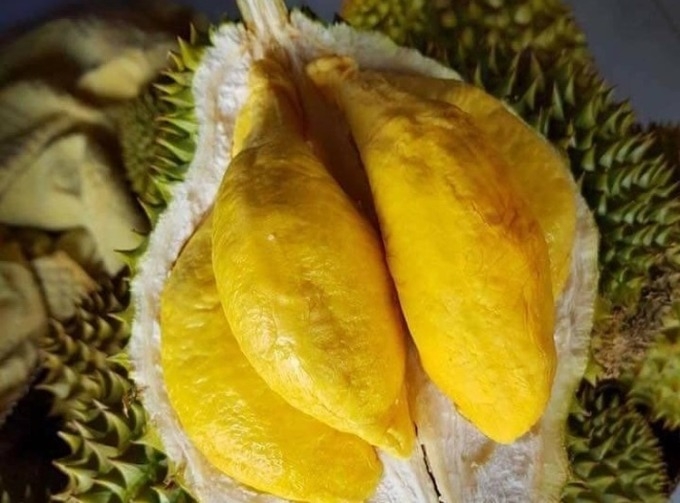Vietnamese dragon fruit is at risk of oversupply, while durian prices will likely plummet as China, the local fruits’ largest importer, continues growing an increasing amount of the two trees.
 |
|
Durian sold in a store in HCMC. Photo by VnExpress/ Hong Chau |
Late last month, China announced its dragon fruit output had reached 1.6 million tons a year, 200,000 tons higher than Vietnam’s output.
According to Chinese customs’ statistics, Chinese demand for dragon fruit is some two million tons a year.
Regarding durian, China imported over 800,000 tons of the fruit worth some US$4 billion last year.
But the giant economy it is likely to import less this year because after years of failed experiments, the country’s farmers are finally growing the fruit successfully in China’s southern regions, according to experts.
The Chinese Academy of Tropical Agricultural Sciences in Hainan Province reported that China’s southern provinces are growing over 2,000 hectares of durian, amounting to 45,000-75,000 tons of the fruit expected to be sold in 2024.
Durian cultivation will also be expanded to the North, according to the academy.
About 90% of Vietnam’s major agricultural products are exported to China.
So the northern neighbor’s plan to ensure its own local supply of agricultural products puts key Vietnamese farm items exported to the Chinese market at risk of oversupply.
According to statistics from the General Department of Vietnam Customs, 90% of Vietnamese dragon fruit is exported to China.
Tran Ngoc Hiep, director of Hoang Hau Dragon Fruit Company in Binh Thuan Province, told VnExpress that Vietnam’s dragon fruit exports to China in the first months of this year have are already slowing under the weight of increasing supply to the north.
In previous years, China imported more than 300 containers of Vietnamese dragon fruit every day through Vietnam’s northern border gates, Hiep said.
But he added that the figure is now already less than 100 containers.
 |
|
Nguyen Luan’s Muong Man Commune dragon fruit orchard in Ham Thuan Nam District, central Binh Thuan Province. Photo by VnExpress/Viet Quoc |
Currently, Vietnamese dragon fruit prices remain high because local farmers can grow the off-season fruit.
But when Chinese dragon fruit in season, from March to September, Vietnamese dragon fruit will face the risk of oversupply and dropping prices.
Ngo Tuong Vy, vice director of Chanh Thu Export and Import Fruit Company in Ben Tre Province, said if the quality of Vietnamese fruits does not improve, they will lose the Chinese market to Chinese rivals.
Vietnamese durian also has to compete with Thai and Malaysian fruit in the Chinese market.
Phan Thi Tra My, president of the Provisional Vietnamese Business Association in China, said Chinese demand for durian is still high, but if Vietnamese exporters continuing paying more attention to quantity than quality, they will soon find it hard to compete with Thai, Malaysian and Chinese durian.
Vietnam currently has 246 durian growing regions that export China totaling 12,000 hectares. And 97 Vietnamese durian packing establishments are certified for official export to China.
According to the Department of Crop Production at the Ministry of Agriculture and Rural Development, by the end of last year, Vietnam’s total durian-growing area had reached 110,000 hectares, some 35,000 hectares higher than the initial plan.
 |
|
A one-hectare durian farm in Tan Lap Commune, Tan Thanh District, Mekong Delta Province of Long An. Photo by VnExpress/Hoang Nam |
In the first two months of this year, ass durian prices surged dramatically, many farmers in the Mekong Delta and the Central Highlands region replaced their coffee, pepper, and rice fields with durian trees.
The department warned that the uncontrolled increase in durian acreage would lead to oversupply.
To overcome the challenges, Dang Phuc Nguyen, general secretary of the Vietnam Fruit and Vegetable Association, asked the State to help with better planning of growing areas. He also asked the State for help in building a brand for Vietnamese durian.
According to Nguyen, farmers should strengthen their off-season fruit production because Thailand and China cannot.
In China, prolonged cold winters make it difficult for durian trees to bear fruit.
“The Chinese acreage of banana, mango and dragon fruit is increasing sharply, but China still has to import large quantities of fruits when they are not in season,” he said.
Fruit farms and traders should also further tap the domestic market, he added.
Vietnam’s total fruit and vegetable exports in the first two months of this year increased by 17.8% year-on-year to $592 million.
China accounted for 57.5% of all Vietnamese fruit exports, according to the Ministry of Agriculture and Rural Development’s department of agricultural products processing and market development.
- Reduce Hair Loss with PURA D’OR Gold Label Shampoo
- Castor Oil Has Made a “Huge” Difference With Hair and Brow Growth
- Excessive hair loss in men: Signs of illness that cannot be subjective
- Dịch Vụ SEO Website ở Los Angeles, CA: đưa trang web doanh nghiệp bạn lên top Google
- Nails Salon Sierra Madre
 VnExpress News The News Gateway of Vietnam
VnExpress News The News Gateway of Vietnam




